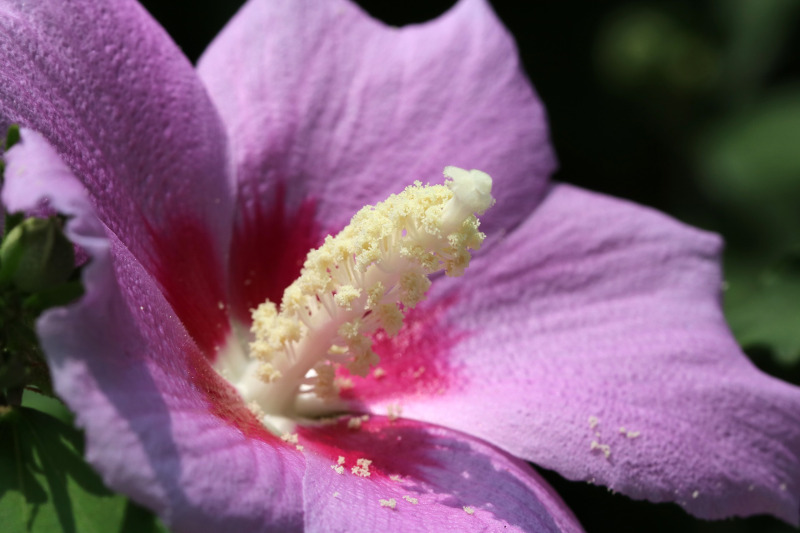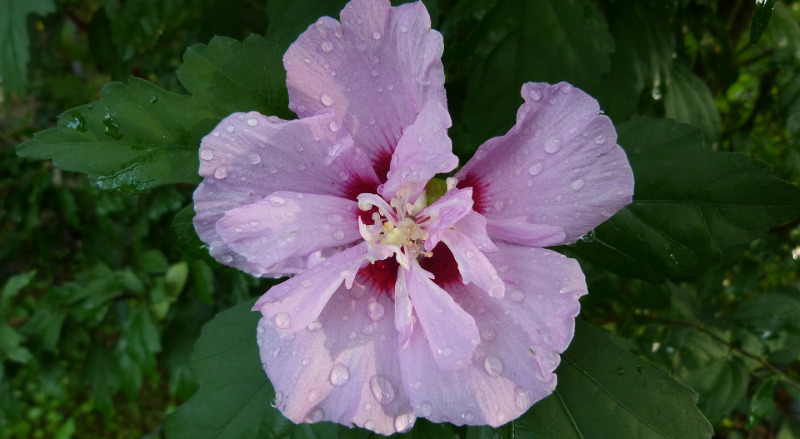Rose of Sharon are hibiscus shrubs that are winter hardy in temperatures up to -20 degrees. Many are winter hardy in growing zones 5 to 9. Hibiscus syriacus is a species of flowering plant in the mallow family, Malvaceae. It is native to south-central and southeast China, but widely introduced elsewhere, including much of Asia. Gardeners love the plants due to the beautiful large tropical flowers in colors including white, red, pink, lavender, blue and bicolors.
Most bushes have plate sized flowers with a long seed pod growing from the middle. Often used as a focal point in gardens, the flowers look beautiful on the plant, but do not make for good cut flowers as they die quickly once cut. These bushes can grow from 3 to 12 feet tall depending on the variety. Rose of Sharon requires full sunlight for best flowering performance and moist yet well drained soil.

Planting Rose of Sharon
When deciding on a location for your Hibiscus, remember that it may reseed a lot. Be prepared to transplant additional plants that may pop up. The Rose of Sharon bush prefers moist, well-draining soil. It will tolerate most soil conditions except those that are soggy or extremely dry.
Plant this flower in the spring or fall. Choose a site that gets full sun. Dig a hole twice the width of the pot and set the plant in. Make sure the crown of the plant rests just at or above the soil line. Backfill the hole, and water well.
Watering Rose of Sharon
Rose of Sharon plants prefer moist, well-drained soil. They do not tolerate drought conditions well and should be watered regularly and up to twice a day in hotter weather. It is best to give your plant a deep, weekly watering throughout the summer months. This will encourage a deep root system.
Frequent shallow water or too much watering can cause the hibiscus to drop it’s buds or become more susceptible to insects and disease. They should not be left in standing water as this can promote root damage/root rot.

Fertilizing Rose of Sharon
When first planted, give your plant a dose of general-purpose fertilizer. This gives the newly planted shrub enough nutrients to sustain the rose of Sharon its first year. Mix the fertilizer in with the soil as you fill the planting hole and water well afterwards. Annually, a Rose of Sharon should get a spring feeding just as the leaves are emerging. Use a light application of a balanced fertilizer such as a 10-10-10 or 10-20-10 fertilizer.
Mid summer, you can give it another feeding with a low-nitrogen fertilizer. Follow the package instructions and water well after the application to prevent burn.
Pruning Rose of Sharon
Rose of Sharon needs little to no regular pruning and is usually done to maintain size, shape, and appearance. Pruning can be done in the late winter or early spring, just before new growth emerges. The buds and flowers form only on the new growth each year. Pruning stimulates new branching. More branching means more blooms. You can remove the weakest stems and all the branches, up to approximately half the height of the shrub.

Caring For Rose of Sharon in Pots
Rose of Sharon is a popular container plant that can be brought inside for the winter. Choose a large container that has drainage holes. Use a good quality potting mix and house the container in a location that gets full sunlight. This plant should be watered regularly and up to twice a day in hotter weather as water moisture in a container evaporates at a faster pace. Continued blooming of this plant quickly depletes nutrients. It is best to repot the plant each year with fresh soil.
Winter Care for Rose of Sharon
To prepare the Rose of Sharon for winter, cease fertilizing in July. This prevents new growth from beginning as the plant prepares to store energy for winter. In most growing zones, this plant needs little care for the cold weather months. Hardy varieties will die back to the ground in the winter in colder regions, but new growth will develop in spring from the root tops.
In colder climates, mulch around the base of the plant to insulate the roots. Some varieties of hibiscus actually require freezing to promote new growth. Late winter pruning can be beneficial for new growth in the spring.
Common Rose of Sharon Care Questions
What Is The Lifespan Of Rose of Sharon?
A Rose of Sharon can live and thrive, and even produce blooms for 20 or 30 years!
Are Rose of Sharon Invasive?
Some Rose of Sharon can be considered to be a bit invasive, as they produce a plethora of easily germinated seeds. This can be avoided by deadheading the short-lived, spent blooms, before they go to seed. There are also plenty of varieties that do not produce viable seeds.
What Is The Size Of The Rose of Sharon?
There are some varieties of Rose of Sharon that at maturity are only 3-4 feet tall x wide and even a few that can be 20+ feet high or 6-10 feet wide, and everything in between!
Why Are Rose of Sharon Leaves Turning Yellow?
Yellow leaves on a Rose of Sharon are most often caused by overwatering, and soil (or a container) that doesn't drain well. They prefer evenly moist, but not soggy soil.
Do Rose of Sharon Plants Spread?
Rose of Sharon is spread by the large number of seeds they produce. You can avoid this by pinching off spent blooms before they go to see. There are also many varieties that only produce non-viable seeds.
Do Rose of Sharon Come Back Every Year?
Rose of Sharon is a deciduous bush. This means they lose their leaves over the winter months but come back in the spring.
What Is The Growth Rate For Rose of Sharon?
Rose of Sharon has a moderately fast rate of growth and can add between 13 and 24 inches in a year.
When Do Rose of Sharon Bloom?
Rose of Sharon generally blooms from mid-summer and into fall though there are some varieties that will start blooming a bit before that, in early-summer.
Have a question about Rose of Sharon? Fill out the form below and we will try and get back to your question as soon as possible. We may even feature your question on this article to help other gardeners!
 |
Author Chris Link - Published 07-02-2021 |
